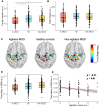Temporal dysregulation of the somatomotor network in agitated depression
- PMID: 39659972
- PMCID: PMC11630518
- DOI: 10.1093/braincomms/fcae425
Temporal dysregulation of the somatomotor network in agitated depression
Abstract
Agitated depression (A-MDD) is a severe subtype of major depressive disorder, with an increased risk of suicidality and the potential to evolve into bipolar disorder. Despite its clinical significance, the neural basis remains unclear. We hypothesize that psychomotor agitation, marked by pressured speech and racing thoughts, is linked to disruptions in brain dynamics. To test this hypothesis, we examined brain dynamics using time delay estimation and edge-centre time series, as well as dynamic connections between the somatomotor network (SMN) and the default mode network in 44 patients with A-MDD, 75 with non-agitated MDD (NA-MDD), and 94 healthy controls. Our results revealed that the neural co-activity duration was shorter in the A-MDD group compared with both the NA-MDD and controls (A-MDD versus NA-MDD: t = 2.295; A-MDD versus controls: t = 2.192, all P < 0.05). In addition, the dynamic of neural fluctuation in SMN altered in the A-MDD group than in the NA-MDD group (t = -2.616, P = 0.011) and was correlated with agitation severity (β = -0.228, P = 0.011). The inter-network connection was reduced in the A-MDD group compared with the control group (t = 2.102, P = 0.037), especially at low-amplitude time points (t = 2.139, P = 0.034). These findings indicate rapid neural fluctuations and disrupted dynamic coupling between the SMN and default mode network in A-MDD, potentially underlying the psychomotor agitation characteristic of this subtype. These insights contribute to a more nuanced understanding of the heterogeneity of depression and have implications for differential diagnosis and treatment strategies.
Keywords: agitated depression; edge-centre time series; functional magnetic resonance; time delay estimation.
© The Author(s) 2024. Published by Oxford University Press on behalf of the Guarantors of Brain.
Conflict of interest statement
The authors report no competing interests.
Figures




Similar articles
-
Agitated "unipolar" depression re-conceptualized as a depressive mixed state: implications for the antidepressant-suicide controversy.J Affect Disord. 2005 Apr;85(3):245-58. doi: 10.1016/j.jad.2004.12.004. J Affect Disord. 2005. PMID: 15780694
-
Toward a validation of a new definition of agitated depression as a bipolar mixed state (mixed depression).Eur Psychiatry. 2004 Apr;19(2):85-90. doi: 10.1016/j.eurpsy.2003.09.008. Eur Psychiatry. 2004. PMID: 15051107
-
Abnormal stability of spontaneous neuronal activity as a predictor of diagnosis conversion from major depressive disorder to bipolar disorder.J Psychiatr Res. 2024 Mar;171:60-68. doi: 10.1016/j.jpsychires.2024.01.028. Epub 2024 Jan 16. J Psychiatr Res. 2024. PMID: 38244334
-
Graph theory approach for the structural-functional brain connectome of depression.Prog Neuropsychopharmacol Biol Psychiatry. 2021 Dec 20;111:110401. doi: 10.1016/j.pnpbp.2021.110401. Epub 2021 Jul 12. Prog Neuropsychopharmacol Biol Psychiatry. 2021. PMID: 34265367 Review.
-
Does the FDA proposed list of possible correlates of suicidality associated with antidepressants apply to an adult private practice population?J Affect Disord. 2006 Aug;94(1-3):105-10. doi: 10.1016/j.jad.2006.04.002. Epub 2006 Jun 12. J Affect Disord. 2006. PMID: 16766043 Review.
References
-
- Institute for Health Metrics and Evaluation (IHME) . GBD Results. Seattle, WA: IHME, University of Washington; 2024. https://vizhub.healthdata.org/gbd-results/ (link is external).
-
- Hasler G, Drevets WC, Manji HK, Charney DS. Discovering endophenotypes for major depression. Neuropsychopharmacology. 2004;29(10):1765–1781. - PubMed
-
- Parker G, Paterson A. Melancholia: Definition and management. Curr Opin Psychiatry. 2014;27(1):1–6. - PubMed
LinkOut - more resources
Full Text Sources
